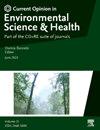壬基酚在农业土壤系统中的来源、影响、命运和生物修复策略
IF 6.6
Q1 ENVIRONMENTAL SCIENCES
Current Opinion in Environmental Science and Health
Pub Date : 2025-03-21
DOI:10.1016/j.coesh.2025.100616
引用次数: 0
摘要
壬基酚(NP)是一种持久性内分泌干扰化合物,已成为陆地生态系统中广泛存在的污染物。虽然大量的研究已经描述了NP污染在水生环境中的作用,但其在土壤中的行为仍未得到充分的研究。本文综述了NP在农业土壤中的污染途径、生态毒理学影响、命运决定因素和生物修复策略。NP主要通过污泥修正、废水灌溉、农药施用和大气沉降等途径进入农田。它通过形态、生理和代谢破坏引起多层次的土壤生态失调和植物毒性。还讨论了影响土壤中NP命运的非生物和生物过程,特别是本地微生物降解和植物吸收。此外,新兴的生物修复策略,主要是生物增强、植物修复和蚯蚓辅助技术,显示出在野外加强NP生物去除的潜力。需要进一步的研究来加强立法,建立毒性终点,并通过与农业生态系统相关的田间试验来调节土壤NP的污染,结合现实的暴露情景和特定作物的人类健康风险评估。本文章由计算机程序翻译,如有差异,请以英文原文为准。
Nonylphenol in agricultural soil system: sources, effects, fate, and bioremediation strategies
Nonylphenol (NP), a persistent endocrine-disrupting compound, has emerged as a widespread contaminant in terrestrial ecosystems. While extensive research has delineated NP pollution in aquatic environment, its behavior in soil remains underexplored. This review advances the contamination pathways, ecotoxicological impacts, fate determinants, and bioremediation strategies of NP in agricultural soils. NP primarily enters farmlands through sludge amendment, wastewater irrigation, pesticide application, and atmospheric deposition. It induces multilevel soil dysbiosis and phytotoxicity via morphological, physiological, and metabolic disruptions. The abiotic and biotic processes, particularly indigenous microbial degradation and plant uptake, that influence the fate of NP in soil are also addressed. Furthermore, emerging bioremediation strategies, mainly bioaugmentation, phytoremediation, and earthworm-assisted technologies, show potential in enhancing NP bioremoval in the field. Additional research is necessary to strengthen legislation, establish toxicity endpoints, and regulate contamination of soil NP through agroecosystem-relevant field trials, incorporating realistic exposure scenarios and crops-specific human health risk assessments.
求助全文
通过发布文献求助,成功后即可免费获取论文全文。
去求助
来源期刊

Current Opinion in Environmental Science and Health
Medicine-Public Health, Environmental and Occupational Health
CiteScore
14.90
自引率
0.00%
发文量
92
审稿时长
114 days
 求助内容:
求助内容: 应助结果提醒方式:
应助结果提醒方式:


